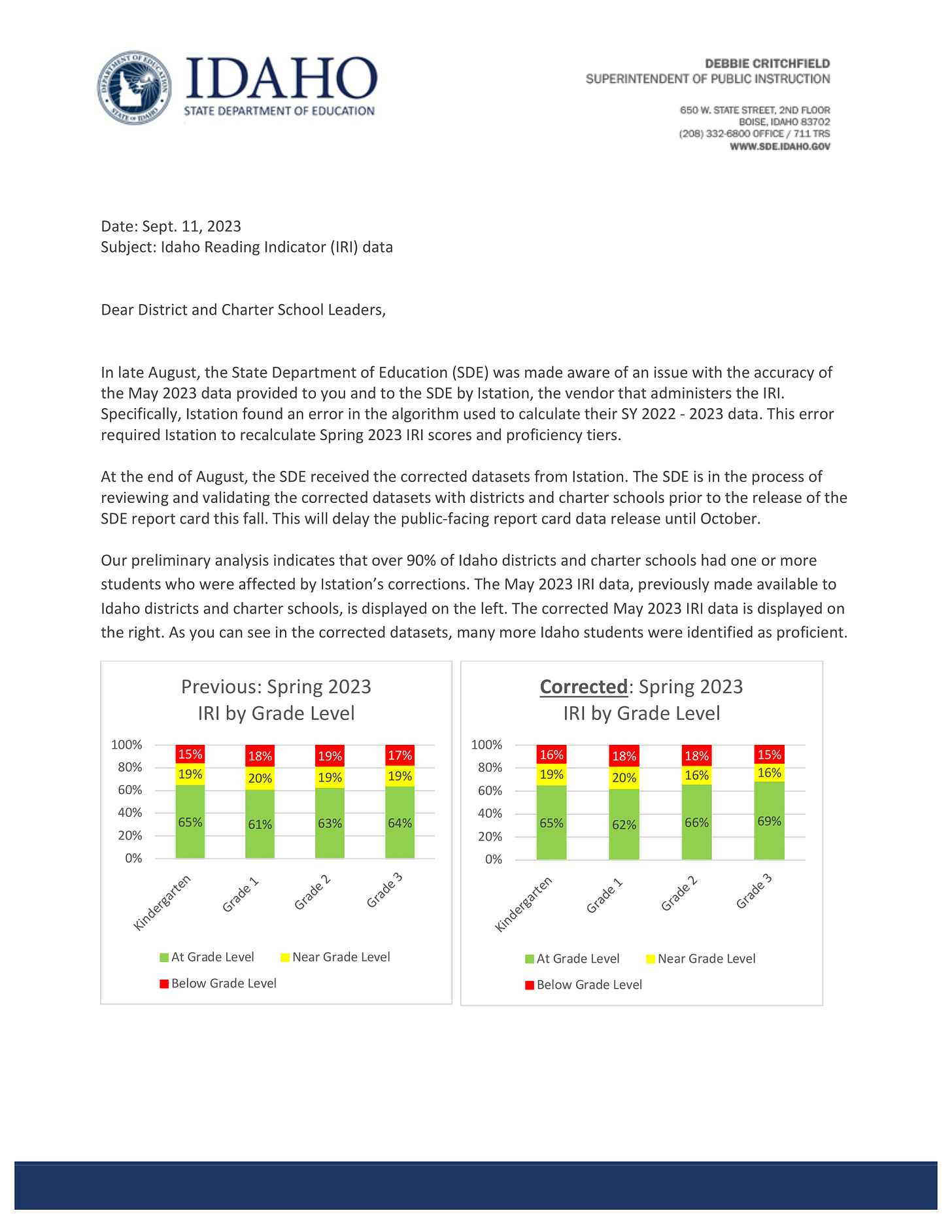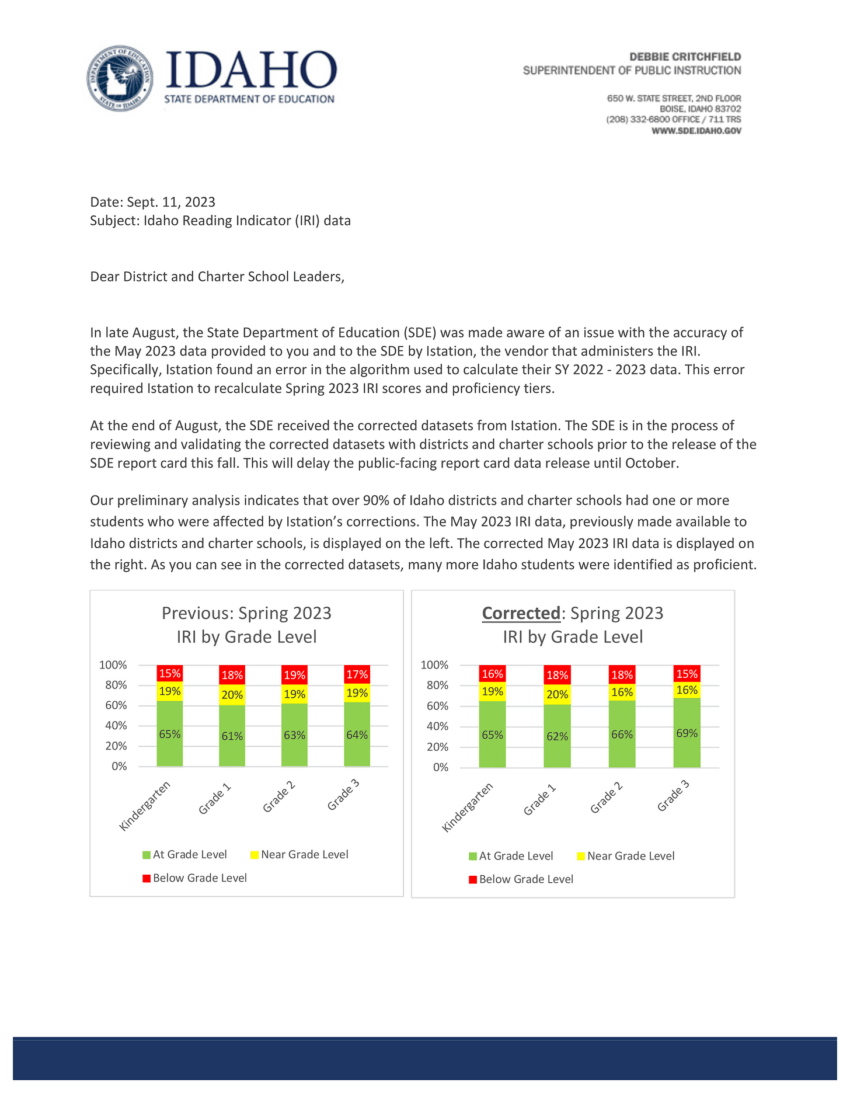Written by Idaho State Senator Brian Lenney:
Earlier this year, the Idaho Department of Education, led by Superintendent Debbie Critchfield, doubled down on outsourcing one of the state’s most critical educational responsibilities to artificial intelligence (instead of human teachers).
The 2025-26 Idaho Reading Indicator (IRI), a high-stakes assessment mandated by Idaho Code 33-1806for all public school students in kindergarten through third grade, is now in the hands of a San Francisco company called “Amira Learning.”
This places San Francisco artificial intelligence at the heart of assessing and guiding young readers in Idaho, not their teachers.
Rise of the Machines
The Idaho Reading Indicator is administered twice yearly and has been a cornerstone of Idaho’s efforts to ensure kids can read by third grade.
Since 2016, Istation’s Indicators of Progress (ISIP) has been the backbone of the IRI, a computer-adaptive test that adjusts question difficulty based on student responses. But the 2025 iteration, powered by Amira’s A.I., takes things to a whole new level.
According to Amira Learning, their system “listens as students read aloud, using advanced speech recognition and natural language processing to continuously assess reading mastery and inform practice and instruction, powering true differentiation.”
Translation: kids as young as five are reading to a machine, and that machine, not a teacher, decides how well they’re doing and what they need next.
Amira’s A.I. apparently identifies reading difficulties in real time, delivers “micro-interventions” based on decades of reading and neuroscience research, and even targets support for students with dyslexia.
But this isn’t about supplementing human teaching. It’s about replacing it.
Teachers & Students Left Behind
Teaching kids to read is one of the most human endeavors in education.
It requires patience, intuition, and the ability to connect with a child’s unique needs. These are things no algorithm can replicate.
Yet Idaho’s decision to lean on artificial intelligence means that K-3 students are reading aloud to a computer, not a teacher who can notice a furrowed brow, a hesitant pause, or that moment when it all clicks.
The system claims to “minimize stress” and “maximize instructional time,” but what does it mean for a kindergartener to perform for a faceless robot instead of a trusted adult?
And what about the teachers, relegated to interpreting web-based reports rather than actively engaging with their students’ reading journeys?
The IRI determines whether kids are at grade level (Tier 1), near or below grade level (Tier 2), or well below grade level (Tier 3). And these tiers trigger interventions that can shape a child’s educational path for years.
If A.I. misjudges a student’s ability (e.g. due to a speech impediment, background noise) kids could be mislabeled, misdirected, or left behind. And we’ve seen glitches before: in 2023 (my first year in the Idaho legislature), “Istation” (now “Amira”) delivered inaccurate data affecting over 90% of Idaho’s districts and charters, delaying spring IRI results by nearly four months!
Look at this:





Crazy, right?
Yet, despite that track record, Idaho renewed its faith in Istation/Amira for up to five more years!
The decision to stick with Istation/Amira wasn’t a foregone conclusion. Or, was it?
The Idaho Department of Education sought bids to replace the expiring IRI contract, claiming to have gathered input from nearly 2,000 stakeholders via a survey.
But whispers in some education circles suggest the process was anything but open. Allegations are swirling that certain organizations were prevented from responding to the RFP, effectively rigging the game in favor of Istation/Amira.
- In 2016, Istation was the low bidder at $64,350for a pilot program.
- By 2023-24, the cost had ballooned to $724,000 (+1,024.8% increase), and with the new five-year contract, taxpayers can expect to foot an even heftier bill.
- Meanwhile, other vendors like Curriculum Associates, Renaissance, and Cambium (some of whom are on the State Board’s approved literacy intervention list) were seemingly shut out from competing.
Why?
Was it to push Amira’s shiny new A.I. as the future of Idaho education? We’re left with more questions than answers.
This A.I. pivot comes at a time when Idaho’s reading scores are in the toilet.

The state’s investment in literacy, ($5M for phonics-based teacher training in 2025 for instance), shows a commitment to evidence-based practices like The Science of Reading and that is a GOOD THING!
So handing the IRI to A.I. feels like a contradiction, doesn’t it?
Because The Science of Reading emphasizes human-led, explicit instruction in phonics, not automated interventions. To be fair, studies, like this one from Johns Hopkins in 2020, show Istation’s ISIP correlates with reading gains… but only when paired with teacher-driven instruction!
A.I. isn’t the silver bullet it’s being sold as.
Not all kids have equal access to the tech needed for Istation’s browser-based or app-dependent platform, especially in rural Idaho. And while Amira touts “linguistically authentic and culturally responsive” assessments, there’s no guarantee its algorithms are free from bias, particularly for English learners or students with disabilities (yeah, I went there).
The 2020-21 Idaho Literacy Intervention Program Evaluation noted that the covid scamdemic already disrupted learning, with some schools struggling to administer the IRI due to tech limitations.
So betting on A.I. in this context feels like putting a band-aid on a broken system.
Bottom-line: Idaho kids deserve better than to have their reading skills judged by a machine, especially one backed by a company with a history of data errors and a shady selection process.

Debbie Critchfield’s decision to entrust the IRI to Amira Learning smacks of prioritizing flashy tech over proven pedagogy.
Teachers, parents, and taxpayers should demand answers:
- Were other vendors sidelined?
- Why are we spending millions to let A.I. teach our kids to read when human educators, armed with The Science of Reading, could do it better?
If we’re serious about literacy, we need to invest in teachers, not algorithms.
We need transparency, not secret deals. And we need to trust the humans in the classroom, not the machines in the cloud. Until then, Idaho’s Big Education experiment with A.I. is a gamble we can’t afford to lose.
Idaho kids’ futures are on the line.
Let’s make sure they’re in human hands.
The post Idaho Big Education Hands Over K-3 Reading to Artificial Intelligence appeared first on Media Right News.
Click this link for the original source of this article.
Author: Support
This content is courtesy of, and owned and copyrighted by, https://mediarightnews.com and its author. This content is made available by use of the public RSS feed offered by the host site and is used for educational purposes only. If you are the author or represent the host site and would like this content removed now and in the future, please contact USSANews.com using the email address in the Contact page found in the website menu.





